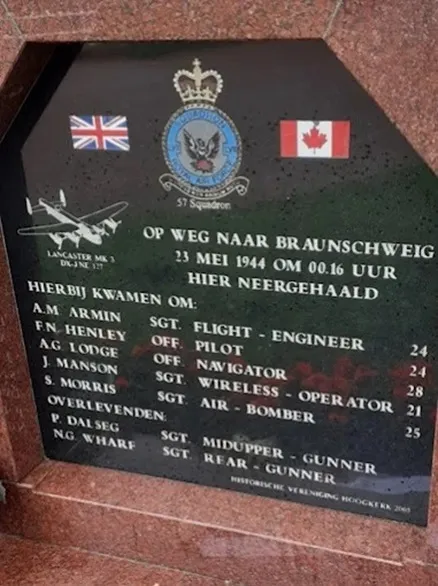Henley,Francis Norman
Killed in Action 1944-05-23


Birth Date: 1921
Born:
Home:
Enlistment:
Enlistment Date: Unknown
Service
RAFVR
Unit
57 (B) Sqn- Squadron (RAF)
Corpus Non Animum Muto I change my body, not my spirit
Base
RAF East Kirkby
Rank
Pilot Officer
Position
Pilot Officer
Service Numbers
172463
Target
 Brunswick Germany
Brunswick Germany

Lancaster Mk.III NE127
Bombing Brunswick Germany 1944-May-23 to 1944-May-23
(B) Sqn (RAF) East Kirkby
Took off from East Kirkby at 22:23 in Lancaster Mk III (Sqn code: DX-J Bomber Command).
Crashed Dorkwerd, Groningen
225 Lancasters and 10 Mosquitoes of 1 and 5 Groups. 13 Lancasters lost, 5·5 per cent of the force.
This raid was a failure. The weather forecast had predicted a clear target but the marker aircraft found a complete covering of cloud. There was also interference on the Master Bomber's radio communications. The 5 Group method could not cope with these conditions and most of the bombing fell in the country areas around Brunswick. The city records show only a few bombs and there were no casualties. A reconnaissance aircraft flying through this area an hour later found it completely free of cloud.source: The Bomber Command War Diaries, Martin Middlebrook and Chris Everitt
This bomber team was downed by a Luftwaffe night-fighter in the night of Monday 22nd / Tuesday 23rd of May 1944, at 00.16 hrs. local time, during an RAF air raid on Braunschweig (Brunswick), in Central North Germany; it was hit by gunfire, given by Uffz. Herbert Meyer + aircrew (of unit 8. / NJG. 1 - started from "˜Fliegerhorst' Leeuwarden), and caught fire immediately and fell down, out of control. Then it exploded soon in mid air - because the crew couldn't drop their bomb load ! - and the remains of the craft and the killed crew came down nearby Dorkwerd village, situated NW of Groningen city, in the Province of Groningen, in the NE part of the Netherlands; only two men survived, of which one fell in a local water, without using his parachute ! (he was badly wounded, had many burns)
This aircraft, equipped with H2S radar (in a "˜bulge' under its fuselage) etc., was in fact brand new (!), was delivered to No. 57 Sqdn. on Tuesday the 16th of May 1944, thus circa 1 week earlier; it had flown only about 7 hours ! The Luftwaffe "˜Flugzeugführer' (= pilot), Uffz. Herbert Meyer, who claimed this "˜victory', was only 20 years old; born on 14 Aug. 1923, at Marienwerder, in today's Kwidzyn town, in Pommeren / Poland. This was his first "˜confirmed kill', and wireless supported by the "˜Jäger Leit Offizier' (JLO) of the coastal radar and air control station "˜Schlei' on Schiermonnik-oog Island, in occupied Holland; this Luftwaffe station "˜shadowed' constandly the RAF bomber with her Würzburg radar, after it was detected first with her long distance Wassermann M radar (range about 300 km.)source: Reearched / collected / compiled by Willem de Jong, Menaam village, Friesland / Netherlands.
Avro Lancaster

Canadian Warplane Heritage Museum
The Avro Lancaster is a British Second World War heavy bomber. It was designed and manufactured by Avro as a contemporary of the Handley Page Halifax, both bombers having been developed to the same specification, as well as the Short Stirling, all three aircraft being four-engined heavy bombers adopted by the Royal Air Force (RAF) during the same wartime era.
The Lancaster has its origins in the twin-engine Avro Manchester which had been developed during the late 1930s in response to the Air Ministry Specification P.13/36 for a capable medium bomber for "world-wide use". Originally developed as an evolution of the Manchester (which had proved troublesome in service and was retired in 1942), the Lancaster was designed by Roy Chadwick and powered by four Rolls-Royce Merlins and in one version, Bristol Hercules engines. It first saw service with RAF Bomber Command in 1942 and as the strategic bombing offensive over Europe gathered momentum, it was the main aircraft for the night-time bombing campaigns that followed. As increasing numbers of the type were produced, it became the principal heavy bomber used by the RAF, the Royal Canadian Air Force (RCAF) and squadrons from other Commonwealth and European countries serving within the RAF, overshadowing the Halifax and Stirling. Wikipedia
 Library and Archives Canada Service Files (may not exist)
Library and Archives Canada Service Files (may not exist)
 Lancaster Bomber
Lancaster Bomber Wikipedia
Wikipedia Harold A Skaarup Web Page
Harold A Skaarup Web Page